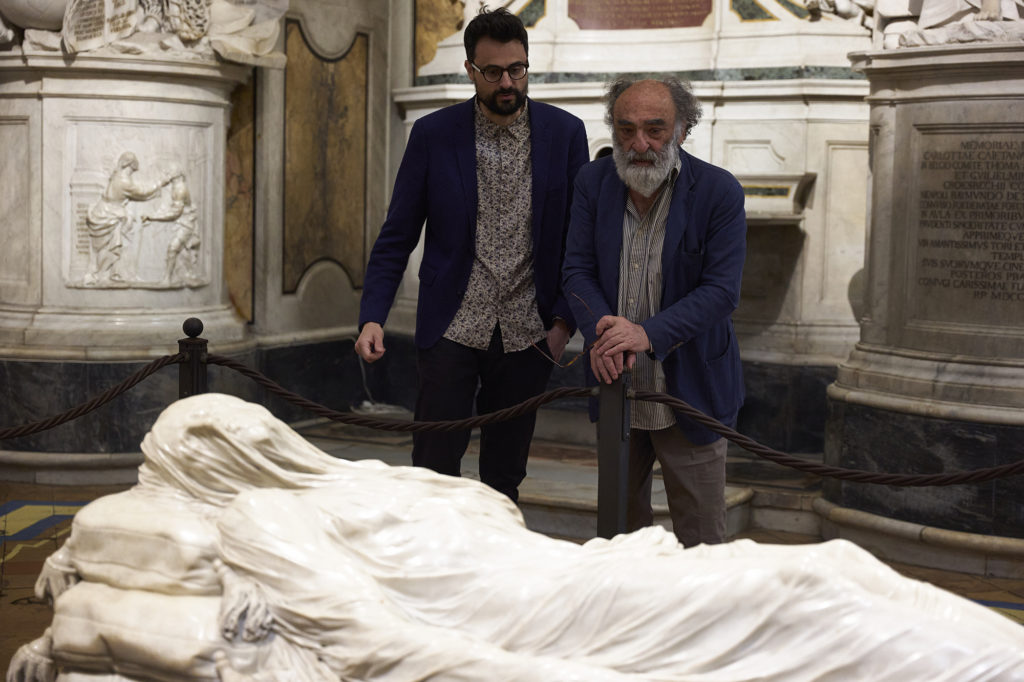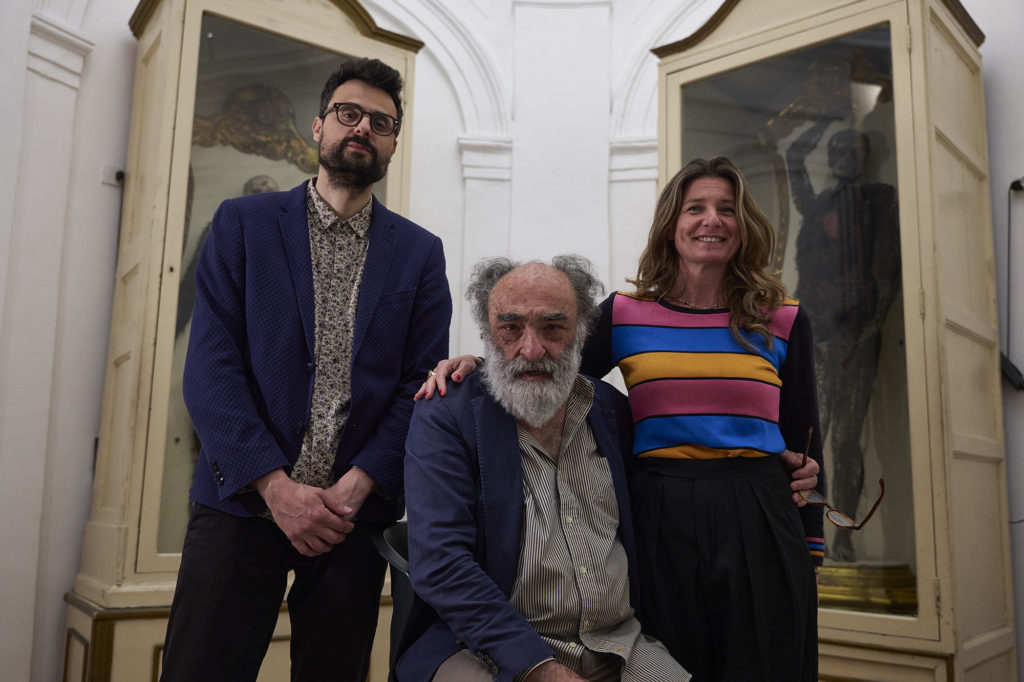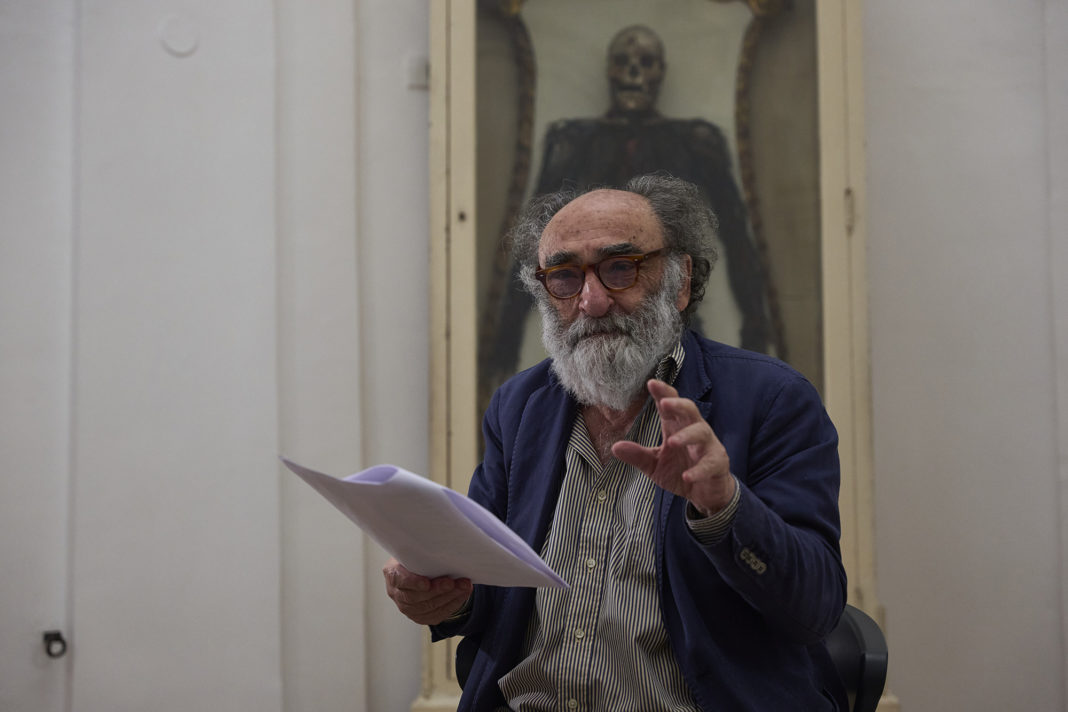«Napoli mi commuove e mi eccita. È come fare l’amore quando sono qui. Una città che mi appartiene, perché universale, a portata di tutti, dove la leggerezza si mescola alla malinconia».
Seduto nella cavea del museo Cappella Sansevero, Alessandro Haber, uno dei protagonisti della scena italiana, ha appena terminato di leggere i versi del poeta, scrittore e critico d’arte Gabriele Tinti per la registrazione della videoperformance che da venerdì 9 giugno sarà sui social del gioiello barocco incastonato nella Napoli antica, dove ancora vibra l’anima di Raimondo di Sangro. E dialoga con i/le giornalisti/e presenti.
Dopo questa tappa napoletana sarà domani a Cesenatico per le riprese del film 50km all’ora diretto da Fabio De Luigi, nel cast con Stefano Accorsi: trai suoi prossimi impegni teatrali, anche La coscienza di Zeno (di Italo Svevo), per la regia di Paolo Valerio.

del principe di Sangro
Siamo davanti alle macchine anatomiche custodite nella cappella, scheletri di un uomo e una donna all’impiedi, per tanto tempo al centro di un macabra leggenda. Si diceva che fossero due corpi cui era stato inoculato un liquido sperimentale capace di “metallizzare” i vasi sanguigni.
In realtà, si tratta di due opere d’arte “veriste”, realizzate dal medico palermitano Giuseppe Salerno (1728-1792), che riproducono alla perfezione l’anatomia umana al maschile e al femminile, realizzata con cera d’api e coloranti.
Haber ha interpretato l’universo poetico di Tinti intitolato “Sanguinamenti” che restituisce al sangue il valore di un rito iniziatico, elemento che ci lega al divino.
Viaggio di un artista nell’immagine creata da un alchimista della parola: due dimensioni che si abbracciano, arricchendosi di sfumature differenti e complementari. Haber legge e lo spazio si riempie d’immortalità: «Ti stringi nel tuo sangue:/ non senti l’ispessimento/ della vena, lil cedimento,/ il varco occluso,// ingordo di vanagloria/ come sei, d’eternità».
Non è la prima volta che la poesia di Tinti irrompe nel tempio del principe illuminato dall’originalità del pensiero: due anni fa a dare voce ai suoi componimenti è stato il regista e attore statunitense, Abel Ferrara.
E lascia un’emozione indelebile: cancella l’angoscia per la morte, accendendo la speranza d’un incessante metamorfosi.
©Riproduzione riservata
Per saperne di più
www.museosanvero.it
Facebook
Twitter
Instagram

“Naples touches me and I feel that it belongs to me; it is a universal city.” Alessandro Haber reads Gabriele Tinti’s poems inspired by Giuseppe Salerno’s anatomical machines
“Naples touches me and excites me. It is like making love when I am here. A city that belongs to me, because it is universal, for everyone, where lightness meets with melancholy.”
Sitting in the cavea of the Sansevero Chapel museum, Alessandro Haber, one of the stars of the Italian scene, has just finished reading the verses by poet, writer and art critic Gabriele Tinti for the recording of the videoperformance that from Friday, June 9, will be on the socials of the baroque jewel set in ancient Naples, where the soul of Raimondo di Sangro still vibrates. And he dialogues with the journalists present.
After this Neapolitan step, he will be in Cesenatico tomorrow for the shooting of the film 50km all’ora directed by Fabio De Luigi, in the cast with Stefano Accorsi. Among his upcoming theater engagements, also La coscienza di Zeno (by Italo Svevo), directed by Paolo Valerio.
We are standing in front of the prince’s anatomical machines housed in the chapel, skeletons of a man and a woman on foot, long the focus of a macabre legend. They were said to be two bodies that had been inoculated with an experimental liquid capable of “metalizing” blood vessels.
In reality, they are two “realist” works of art, created by Palermo physician Giuseppe Salerno (1728-1792), which perfectly reproduce male and female human anatomy, made with beeswax and dyes.
Haber interpreted Tinti’s poetic universe entitled “Sanguinamenti,” which gives back to blood the value of an initiatory rite, an element that binds us to the divine.
Journey of an artist in the image created by an alchemist of the word: two dimensions that embrace each other, enriching themselves with different and complementary nuances. Haber reads and the space is filled with immortality: “You clench in your blood:/ you don’t feel the thickening/ of the vein, the subsidence,/ the occluded gap,// greedy with vainglory/ as you are, with eternity.”
This is not the first time that Tinti’s poetry has burst into the temple of the prince illuminated by the originality of thought: two years ago it was the U.S. director and actor, Abel Ferrara, who gave voice to his compositions.
And it leaves an indelible emotion: it erases the anguish over death, bringing the hope of unceasing metamorphosis.










